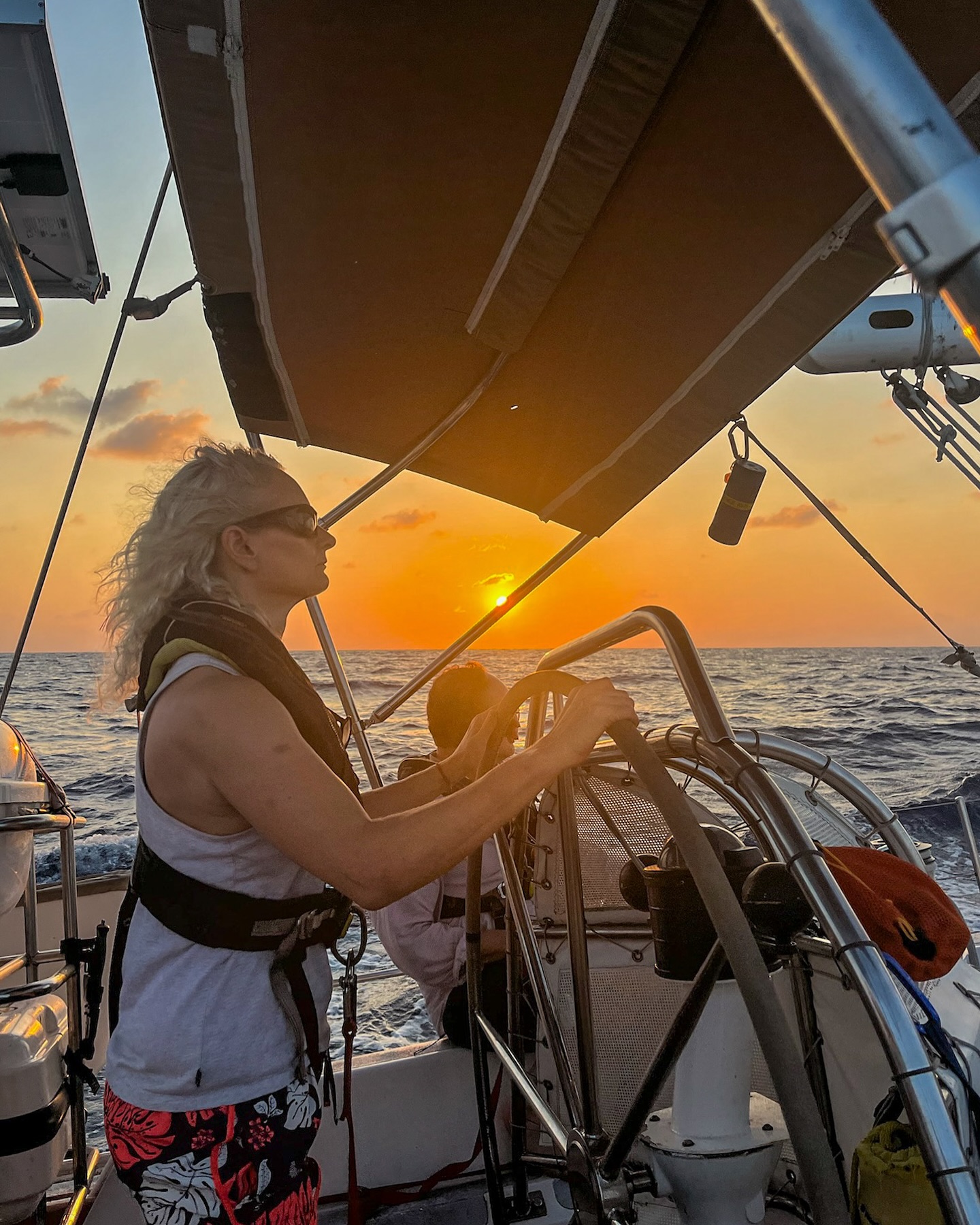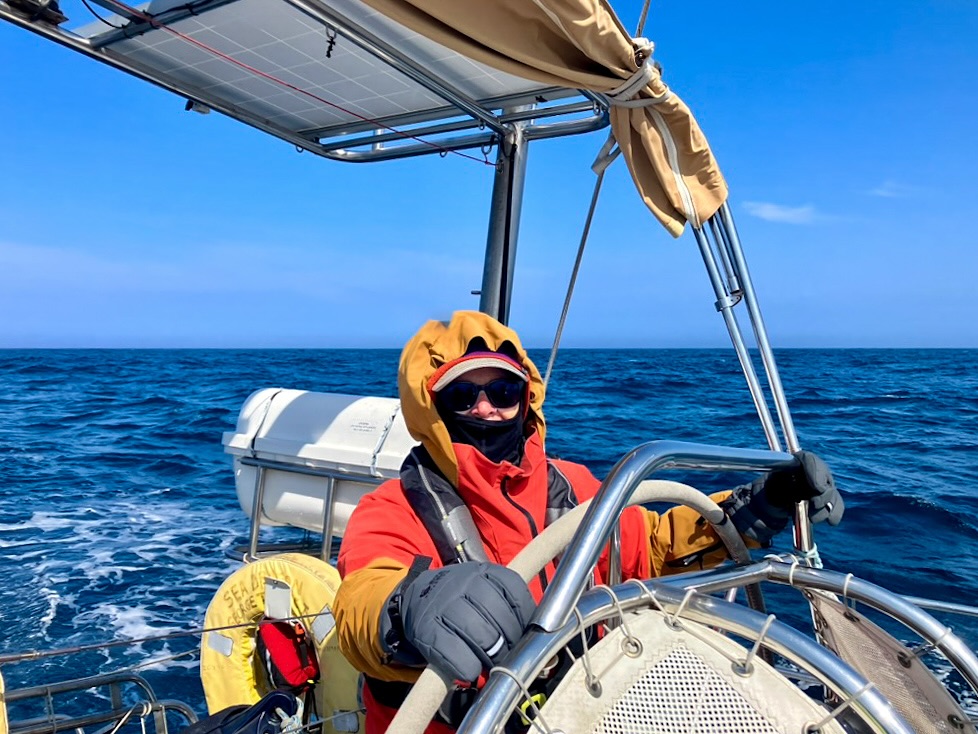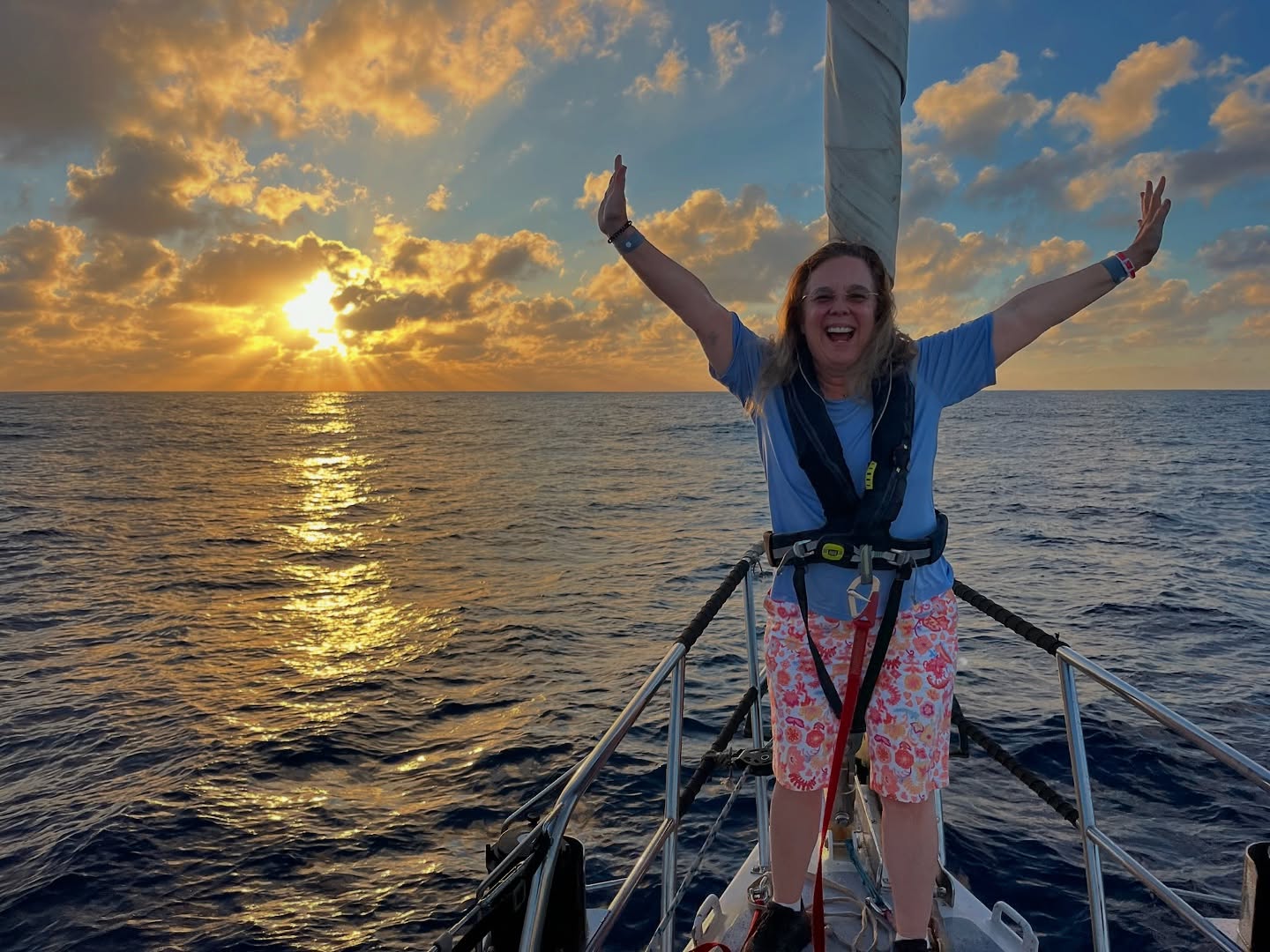Christmas Island – Kiribati
by Charlie Triggs – Deckhand aboard Sea Dragon.
After three hours sleep since my 00:00 till 04:00 watch, I came up the companion way into an overcast and breezy morning. At 002.03.9N, 157.37.7W Christmas Island had appeared on the horizon as a long line of coconut trees. The northern shore meets the northern swell with a large surf visible with the naked eye. Towards the south the trees are intermitted with human structures; a pier, fuel tanks, and a radio mast. The line of trees end and the horizon is flat, rather than this being open ocean, this is just the entrance to the inner lagoon of Christmas Island; the biggest atoll (by land mass) on our planet. The 6,000 residents moved here from Tarawa, the main island of Kiribati, which is made up of many pacific islands. There is an airport with one flight a week, three towns, and a pier where most goods are imported onto the island (The shipment containing ice cream comes every three months).
Sea Dragon made a beeline towards the pier and folded her wings as we approached, after circling in the shallows to check the depth and holding, we anchored in 14 metres of water just North of the pier. Being anchored is very different than being moored to a dock. You have the feeling of being safe and secured to your surroundings without being tied to anything solid. You have the comfort of land but still your own space and freedom, isolated but within reach of everything you need. You are still at the mercy of, yet still comforted, by the wind and the sea.
On arrival the usual activities took place. The staysail was flaked, bricked and bagged. The new dinghy was rebuilt (this time with the 25hp on the back for bit more oomph). The fuel tank was refilled from the extra jerry cans we had loaded in Hawaii. Whilst re-flaking the main sail onto the boom, Eric noticed a few more tears in the sail. Sea Dragon will have a brand new main sail on returning to Hawaii, and so the current one is on its last legs. Extra care is needed while handling the 1200 odd square ft of canvas to prevent any further damage. To repair sails there is a sticky back dacron that is placed on one or both sides of the sail over the tear. To hold the patch in place as it drys we also sewed around its perimeter. Sewing is great to hold a patch in place, however it also introduced a lot more holes into an already fragile sail. Laminate sails can also tear but these can’t be sewn through. Thankfully there is an incredibly sticky adhesive know as 5200 that sticks sails back together. Take note that you should do everything to avoid getting this into your hair, as Shanley has found out the hard way. We used a combination of sewing and 5200 for the larger patches on the sail.
During the morning’s productive proceedings Eric shouted for everyone to look over the starboard side. I hadn’t heard this tone before, there was urgency to his voice but not panic. I was clueless with what to expect as I crawled out from under yards of sail. Just as the others came up the companionway a huge manta ray swam gracefully along the side of the boat. It was around 2 metres broad and was a very impressive welcome to this Pacific paradise. The ray took one slow, inquisitive circle around the boat to welcome us to Christmas Island.
Just as we had finished getting the mainsail on the boom the radio crackled to life with a muffled ‘Sea Dragon, Sea Dragon, this is Christmas Radio’. The officials from customs, police, immigration, biosecurity and fisheries were ready to come onboard and complete the necessary formalities. We picked them up from the precarious and rusty ladder which drops 15ft off the edge of the pier into the clear blue water. They came aboard and began the ritual of shuffling and signing many different important pieces of paper. We waited patently on our best behaviour whilst trying to distract ourselves from our rumbling stomachs. The process was surprisingly efficient and before long we were back holding onto the ladder with a hand out to help the officials climb from the dinghy back onto the pier. Eric subtly caught my attention and pointed into the water behind us. I let out a very unofficial chain of words as the manta ray splashed at the surface an arms length away. Whoops.
With stage one of entering Kiribati complete Eric still had to go into immigration in London to get our passports stamped. This gave me the chance to practice driving the 25hp outboard, we planed along the coast until we reached the lagoon. Eric stood at the bow looking for the deeper areas and any water disturbance that might be a clue for shallow rocks and coral. The charts of this area are not particularly accurate as it was last surveyed by the British military in the first half of the 20th century, before GPS. We made it to the small boat pontoon in the town of London, everything here looked fairly warn and very sun kissed. Eric left me to boat sit and people watch while he ventured onto shore. Two open top fishing boats moored alongside. They had tangles of buoys, some cool boxes which appeared relatively empty, and a pile of white rounded stones. I’m unsure of the fishing strategy behind this, or whether in fact they had just been out collecting rocks. Over the course of our stay we saw plenty of small motorboats and canoes fishing, as well as a lot of fish at the surface. Fishing is definitely a big part of peoples lives here and the small amount of tourists that come to the island do so for this reason.
Topping up on diesel is a relatively simple task, but its made slightly more complicated when on a boat on a remote pacific island. Two barrels were delivered to the pier which we then syphoned into the empty jerry cans. The first barrel appeared clean but the second had some visible bits of debris and rust. For most big ships the huge filters get rid of this without too much trouble, but on smaller boats and yachts like Sea Dragon, this would clog the filters pretty quickly. We filtered the diesel between empty cans and then lowered them down to the dinghy. As we juggled the jerry’s of diesel our neighbour, Mr Manta, came back to see what all the fuss was about. The locals were amused by our excitement at seeing such an incredible creature so close, one man even threw a rock down to scare it off. No different from us scaring a flock of pigeons at home. Everything is relative, but this island is definitely a world apart from back home in the U.K.
Jess, Shannon and I ventured ashore one afternoon. We followed the broken tarmac road, walking along the sandy verge, scattered with lumps of grey coral and coconut shells. The schools had just finished so there were kids everywhere in their white shirt uniforms. Walking and cycling along the road, getting on the back of motorbikes and jumping in the back of open bed trucks. Most people looked at us, a lot of people smiled at us, quite a few waved, and others just pointed and laughed. I was surprised by the high level of english the kids spoke ‘Hey, what’s your name?, where are you going?’. Everyone was really friendly and two young boys walked with us, they seemed to enjoy the attention they got from seeming to be our tour guides not that a word was spoken between us. They also enjoyed taking the micky out of Shannon, who was taken a touristy amount of photos, ‘click-click’ they went as they took just as many pictures with their imaginary cameras of all the inanimate objects we walked past. The road side was filled with more and more buildings until we realised this was the town of London. Most buildings had corrugated roofs, with some being made from brick. Shops were either the front rooms of peoples houses or dark doorways with a shelf of tin cans just visible. I was surprised by the amount of traffic and people. It was a very hot and dusty place but didn’t seem to be sleepy. The two bars we went past had music blaring out from behind tall bamboo fences.
Back onboard Sea Dragon we had a leisurely few days, swimming off the boat, reading in the hammock and having a Hawaiian beer at sundown. Christmas Island has been fantastic. It is great to have sailed here into such a remote culture and landscape. We are now joined by Woods Hole Oceanographic Institute and are en route on the six day passage to the even smaller and even more remote atoll of Kanton.































